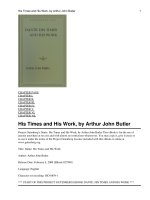Pair and group work
Bạn đang xem bản rút gọn của tài liệu. Xem và tải ngay bản đầy đủ của tài liệu tại đây (113.69 KB, 5 trang )
Overcoming Difficulties in Pair and Group Work
by John Wheeler
An already much researched and discussed topic, pair and group work has taken firm
root in many EFL/ESL classrooms today. As a graduate of a Master's program in
linguistics, however, I felt reluctant to embrace the dogma on the subject, and in my first
teaching position at a university in Turkey, I favored the "safe" traditional methods that I
had used in my own learning of foreign languages.
Years later, I started to feel the need for a more interactive approach to language teaching and learning. I started to
experiment with pair and group work, but as any novice in any field, I found that the going was not always so
smooth. Some of the problems I encountered were:
1. The students often spoke in their native language.
2. One student would dominate while the others listened (or maybe did nothing at all).
3. Students might learn each others mistakes by practicing English together.
4. Students were not clear about how to go through an activity.
5. Some students, being loner types, were simply uninterested in working with others.
6. The class became very noisy with so many people speaking at once.
7. The class seemed to be in a state of chaos.
Problems confronted
A few years later, as I continued to wrestle with this enticing, yet problematic teaching technique, I was able to
come up with the following answers to my concerns:
1. THE LEARNERS WILL SPEAK THEIR NATIVE LANGUAGE IF YOU LET THEM. I learned to make a joke and
say I was the "English Police." My job was, of course, to "cruise" the class looking for offenders. This was all
done light-heartedly, and I sometimes charged a "fine" of a few cents for those who did not speak English,
using the money later for a party or game prize. In any case, I found the more I circulated among the learners
and reminded them to speak English, the easier they found it to comply.
3. LEARNERS DO NOT SEEM TO LEARN ERRORS FROM THEIR PEERS. In fact, in my experience, the reverse
seemed to be true: no matter how much perfect native-speaker English the students heard, errors were an
inevitable part of the learning/acquiring process. One of the main points of having learners speak with each
other was to help them increase their confidence and reduce the anxiety that is often found in a purely teacher-
centered classroom. Pair- and group- work activities were often (but not exclusively) geared to fluency
enhancement rather than accuracy practice.
2. ASSIGN ROLES. To avoid one learner taking over the activity and others becoming passive observers, I
assigned roles to each of the members of a group: a "secretary" notes down what the group members say; a
"leader" governs role taking as different members speak; and a "presenter" reports on the final conclusions
reached by the group. Even if the teacher does not follow up on each member's task after the activity is
finished, the assignment of roles is often enough to act as a catalyst to get the group speaking. It is a good idea
to assign tasks to dissimilar learner types. For example, let the usually taciturn learner be the reporter, the
noisy one be the secretary, and the sheepish learner be the leader.
4. MAYBE THE TEACHER IS THE PROBLEM. The reason why learners were unclear about an activity was
often due to a fault of mine. I found that when I believed an activity was going to work, the learners started
to believe it too, and did it! In many cases, just a few seconds for reflection or a moment for students to ask
questions meant the difference between a successful and an unsuccessful activity.
A sample procedure
At this point in my discussion, I would like to offer a suggested procedure for using pair and group work that I
have found to be generally successful:
5. MANY PEOPLE ARE INDEPENDENT TYPES AND PREFER WORKING ALONE. However, given the reality of
life, there are not many professions today that allow one to work in pure isolation. Cooperation is a fact of
life, and having learners work together in the classroom teaches them a very important life skill. Teaching
learners how to work with others and not constantly rely on the teacher for everything is an integral part of
EFL/ESL. If a student really insisted on working alone, I tried to devise an activity that was motivating to
such an extent that it was difficult to get the student to stop when the class hour was up.
6. THE NOISE FACTOR USUALLY IS MORE TROUBLESOME TO THE TEACHER THAN IT IS TO THELEARNERS.
Participants in a pair- or group-work activity were normally unaware of what other groups or pairs were
doing. The only possible problem here could have been if the class had particularly thin walls. If the activity
were organized well and learners were all actively speaking, then I could let them make noise, because it
was productive noise.
7. HOW DO YOU DEFINE CHAOS? In a focused "cocktail" activity, where all the learners were on their feet
and talking, such as in a "Find the person who . . ." activity, the resulting chaos was, in fact, productive
interaction among information-seeking learners of English. On the other hand, if learners were wandering
around the class not knowing what to do, or if they were asked to participate in an activity that lacked clear
goals or aims, then this could have been described as real chaos.
1. Explain the activity. Make sure the learners know exactly what they have to do. Go over directions
carefully, and give them time to ask any questions they may have.
2. Arrange the groups. Just telling the learners to "get into pairs/groups" is not enough. Many times the
teacher must actually show learners who they must work with. If there is an odd number of students for the
groups, incorporate the "odd" learner into another group. Desks may have to be moved (if possible), and roles
as described above could be assigned at this point. Innovative seating arrangements can be experimented with,
such as "tango seating" (Samuda and Bruton 1981). Also, learners can be regrouped from activity to activity
using techniques such as numbering off, giving out cards categorized into related topics, separating learners
according to the color of their eyes or clothing or their sign of the zodiac, giving them pieces of a puzzle to
put together, or even pulling strings held by their classmates to find their partner.
3. Set time limits. Giving a rough time limit gives a sense of urgency to an activity. It is also a good idea to
stop an activity after most of the groups have finished so that the whole class is not left waiting for the last
ones to finish. Those who are not allowed to completely finish do not lose much since the activity will be
spot-checked in some way (see below).
4. Give examples or demonstrations. Before the whole class is thrown into pairs or groups, give as many
examples as necessary to make sure the class has the idea. The teacher can model the activity with a learner or
two and then let other learners perform the activity until the whole class can begin work on their own. This
ensures that the class understands what to do and how to do it and the teacher does not have to interrupt them
in order to give the instructions again.
5. Circulate. A teacher's work never ends! Some of the things a teacher should be doing while the students are
working away include playing "English Police" (see above), making sure all students understand and are
participating in the activity, giving assistance when needed, making on-the-spot error corrections when
communication among the group members is hampered, and making notes on errors that can be discussed
after the activity.
6. Follow up. Let learners report to the class on either what their group discussed or what their partner told
them. For example, if the exercise is on likes and dislikes, a few learners could tell the class what they learned
about their partner's preferences, instead of repeating what they told their partner about themselves. It is not
necessary that every student report, but it is important that every learner have the chance to practice with their
classmates during the activity.
7. Discuss the activity. The teacher can extend the activity into a full-class discussion, examine errors that
students made during group work, or discuss general problems they may have had with the exercise. Follow
up and discussion of an activity are necessary so that learners feel that they are working purposefully.
Conclusion
I hope this discussion of techniques for overcoming the difficulties of pair and group work will be of use to
struggling new teachers, as well as serving as a summary/refresher for experienced teachers well acquainted
with the subject. Pair and group work is a valuable classroom technique that is here to stay!









